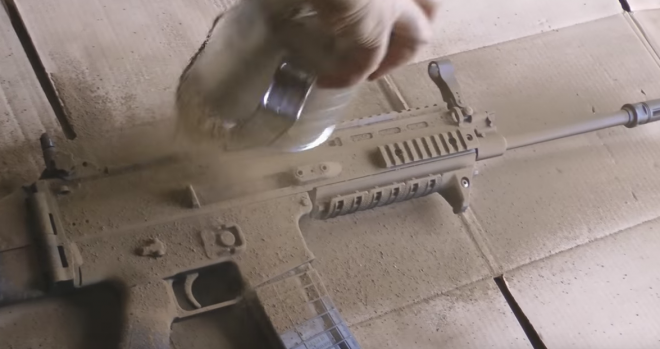Dust, mud, dirt, sand: Ideally, a firearm should be kept clean and free of debris so that it functions optimally at all times. After all, the user’s life may depend on the firearm working properly!
Sometimes, though, the worst happens and a firearm is exposed to the elements in such harsh conditions that even the toughest rifle may fail. To that end, debris tests help give an idea of which firearms perform the best when exposed to detritus and which rifles need to be kept immaculately clean to function, and all points in between. Previously we’ve covered mud and sand tests conducted by Guns & Ammo TV, InRange TV, and the Military Arms Channel on everything from the AK to AR-15 to the Vz. 58, to the MAS-49.
To add a few more data points to the set, we’ll take a look at TangoFoxtrot’s two dirt test videos, the first of which covers the Mini-14, AR-15, and Steyr AUG:
More than two years later, TangoFoxtrot conducted an even more thorough test on the Mini-14, AR-15, ARX-100, SCAR-16S, and Arsenal SLR-107FR (AK-103 clone):
The results were surprising to them, but if you’ve been following these articles they shouldn’t be too shocking:
Mini-14 w/ grease – 1 round
Mini-14 w/ CLP – 1 round
AR-15 – 32 rounds
ARX-100 – 31 rounds
FN SCAR 16S – 12 rounds
SLR-107FR – 1 round
The second TangoFoxtrot test has some positive and negative aspects to its methodology. On the plus side, the test was conducted in an especially controlled fashion, with a sieve acting to provide each rifle with an even, uniform coat of fine dust, helping to eliminate error caused by differently sized particulates. Also, the rifles were all dusted while on safe and initially with their dust covers closed (if applicable). After the second (dirty) ten rounds, the dust cover was left open (where applicable), another plus.
On the negative side, the rifles were retired as soon as they had a malfunction of any kind, which halted any exploration of whether the rifles would keep functioning with the assistance of manual operation, or whether the rifles could be successfully put back into action with remedial action. The rifles were then rated only according to how many rounds they fired before malfunction, which limited the utility of the results. Finally, the SCAR 16S was tested (probably by accident) with the regulator on the “suppressed” setting, which almost certainly led to its premature malfunction.
Having said all that, the TangoFoxtrot tests are still informative. Once again, the AR-15 proves to be a remarkably dust-resistant rifle, in spite of the reputation it received in the GWOT. The AK puts out a particularly poor performance (although it possibly could have continued working with manual assistance), but the true loser of the test is once again the Garand-style open action, in this case in the form of a Ruger Mini-14.
Thanks to commenters mosinman and Gecko9mm for the tip!
UPDATE: The SCAR owner writes …
The complete story is that I thought the SCAR was horribly overgassed when I first got it. Even with the gas regulator set to the suppressed setting it flung brass and the bolt carrier crashed into the buffer.
So I got a set of gas screws (that form the actual gas port) and tuned it for the ammo I actually shoot. I set the gas regulator to suppressed, inserted the smallest gas screw (1.00mm) and fired from a magazine loaded with only one round. I kept increasing the gas screw size until the bolt carrier locked open on the empty mag, then went up 2 sizes (the gas screws come in 0.05mm increments) for a little reserve power.
When we did the test about two or three years later I had completely forgotten that I had set up the gas system that way. If I had remembered I would have returned the rifle to the stock configuration before shooting.
Two other notes:
1) All the rifles were shot with a new, clean magazine.
2) The reasoning for stopping after the first malfunction was to keep everything similar and make the whole run shorter. The first test with the Mini-14 and the AUG was a miserable experience in hammering the Mini’s bolt open and shut after it choked.I just wanted to clear up what actually happened with the SCAR, just plain incompetence, not malice.
 Your Privacy Choices
Your Privacy Choices
